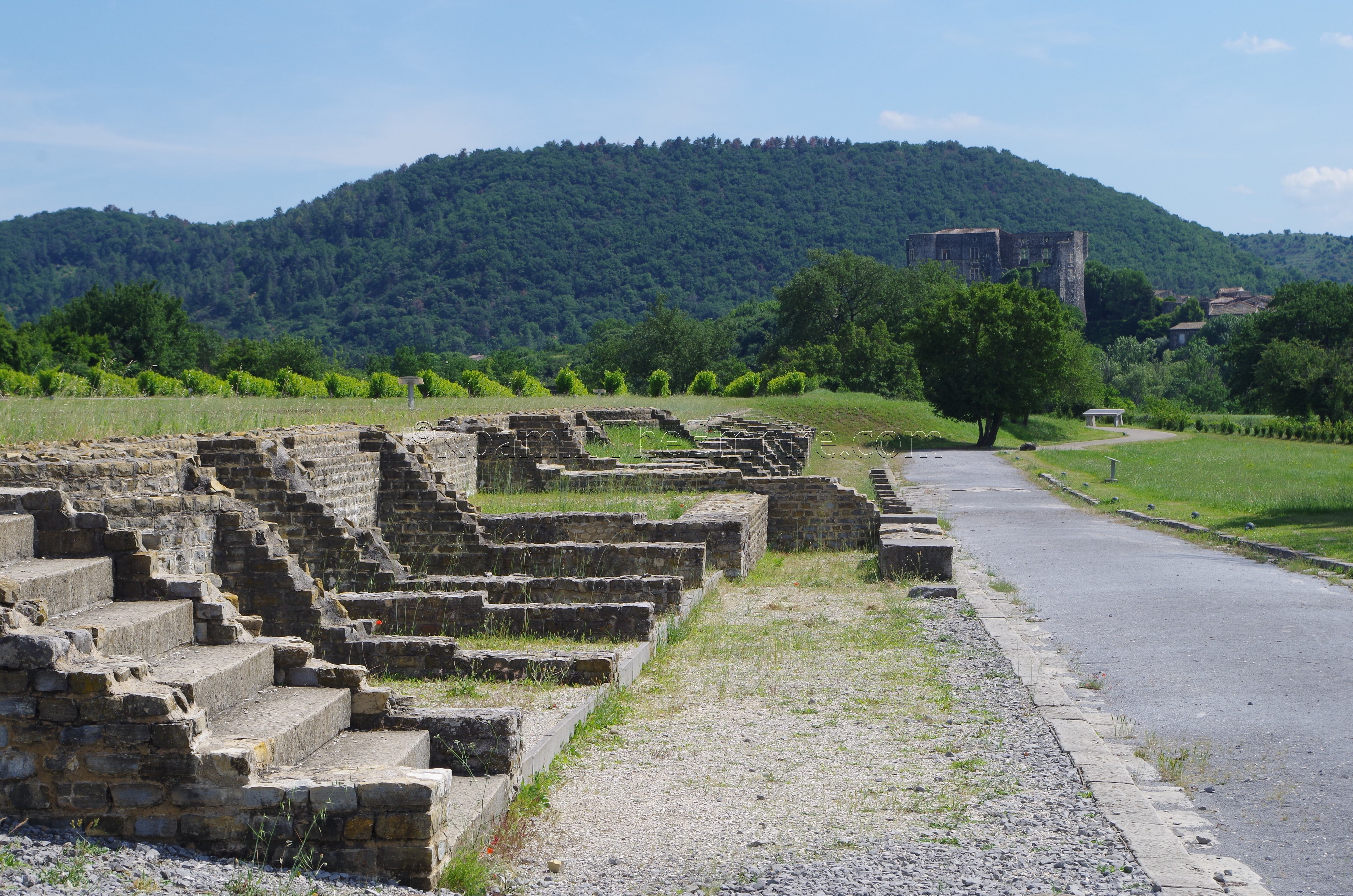
Most Recent Visit: June 2018.
Tucked into a fertile agricultural valley about 7 kilometers to the west of the Rhône, along the L’Escoutay River, a tributary of the Rhône, are the remains of the Roman town of Alba Augusta Helviorum. The archaeological site is located just to the north of the present-day town of Alba-la-Romaine, which draws its name from the ancient city and its Roman heritage. Alba Augusta Helviorum, as the final part of the name suggests, was located in the territory of the Helvii, which generally corresponds to the territory of the modern French department of Ardèche. Not much is known of the history of the site or of the Helvii prior to their contact with the Romans. The general area of Alba Augusta Helviorum seems to have had a related oppidum prior to the founding of a settlement on the present site of the archaeological area, though.
From 121 to 120 BCE, Quintus Fabius Maximus Allobrogicus carried out a campaign against the Allobroges and Averni first as consul and then as proconsul of Gaul. At the time, the Helvii seem to have been allied with the Averni, but following the defeat of the latter, the Helvii entered into an alliance with Rome. It seems to be around this time that settlement started in the immediate area of Alba Augusta Helviorum. Though the settlement at the site of Alba Augusta Helviorum does not seem to have been urbanized during this period, there was heavy Roman influence, and it is noted that the leader of the Helvii, Gaius Valerius Caburus, was given Roman citizenship in 83 BCE by Gaius Valerius Flaccus, proconsul of Gallia Transalpina at the time. Caburus’ son, Gaius Valerius Procillus, was highly regarded by Caesar during his Gallic Campaign.
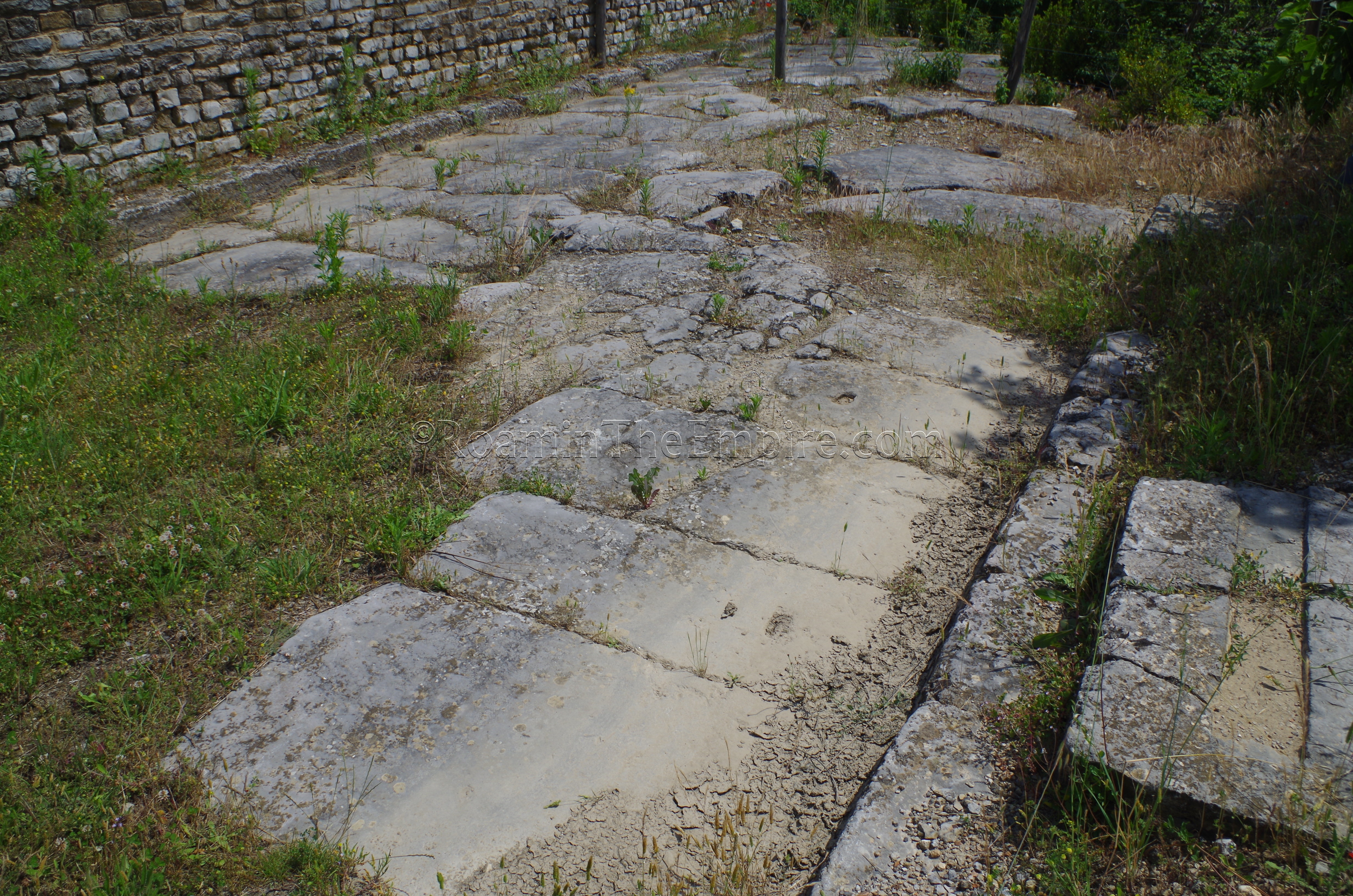
During the Sertorian War of 80 BCE to 72 BCE, it seems that the Helvii supported Sertorius, and as consequence, when he was defeated, the Helvii lost some of their land to Massilia, though it does not seem to have included the area of Alba Augusta Helviorum. Despite their support of Sertorius, the Helvii remained staunch Roman allies. Caesar names and during Caesar’s Gallic Campaign, they provided support to Caesar by blocking the attempts of Vercingetorix to attack through their territory. The Helvii were ultimately defeated, with Caburus’ other son, Gaius Valerius Donotaurus being killed in the battle, and ended up being forced into providing troop levies to Vercingetorix at Alesia. Following Massilia’s support of Pompey against Caesar and subsequent capture by the latter, the territory of the Helvii that was previously ceded to Massilia was returned by Caesar.
Whether or not a Roman settlement was organized on the site of Alba Augusta Helviorum immediately following the Gallic Wars is unclear, but as the name of the city suggests, a colony was established under Augustus as the capital of the Helvii. The fertile valley in which Alba Augusta Helviorum is located proved to be conducive to agriculture, particularly in the cultivation of grapes for the production of wine. Pliny the Elder notes that a variety of grape that blossoms in one day being created at Alba Augusta Helviorum, which eventually was spread elsewhere in the province of Gallia Narbonensis, called carbunicam. The cultivation of this grape and production of wine here likely contributed greatly to the city’s prosperity throughout the 1st century CE. Like many of the other Roman settlements in the area, Alba Augusta Helviorum was sacked by the Alemanni in the waning years of the 3rd century CE, which eventually lead to it’s almost complete abandonment in the middle of the 4th century CE and the transfer of the area’s population center to nearby Viviers.
Getting There:
Given that the department of Ardèche, in which Alba-la-Romaine is located, is rather rural, getting around via public transport is rather difficult. The nearest train station is about 20 kilometers away in Montélimar, and from the train station there, Line 74 of the TER bus lines (Valence TGV/ Montélimar to Aubenas/Les Vans) stops right near the archaeological site (Ruines Romaines stop). The trip takes about 20 minutes and runs about once an hour between 6:45 and 22:45 and costs 1.90 Euro each way. The return frequency is similar. The schedule varies, so it is best to consult the most updated hours here. A bus line also runs from Pierrelatte, which also has a train station, via Le Sept Line 14. This bus service only runs twice a day, but the information can be found here (pdf). The best way to reach the archaeological site, which is also a bit outside of the center of Alba-la-Romaine, is by private vehicle. The archaeological site is located on the north side of the D107 highway, which follows the course of the L’Escoutay River between Alba-la-Romaine and Viviers, and passes north of the center of Alba-la-Romaine.
The Site Archéologique d’Alba la Romaine has a small museum on-site, the MuséAl, and is located with an address of Quartier Sant-Pierre D107, Alba-la-Romaine. The museum and site have a rather complicated scheme of opening hours that depend on the time of year and the school holidays, so rather than try and replicate it here, it would be easiest just to link to the museum website’s tables. Combined admission to the archaeological site and museum is 5 Euros.
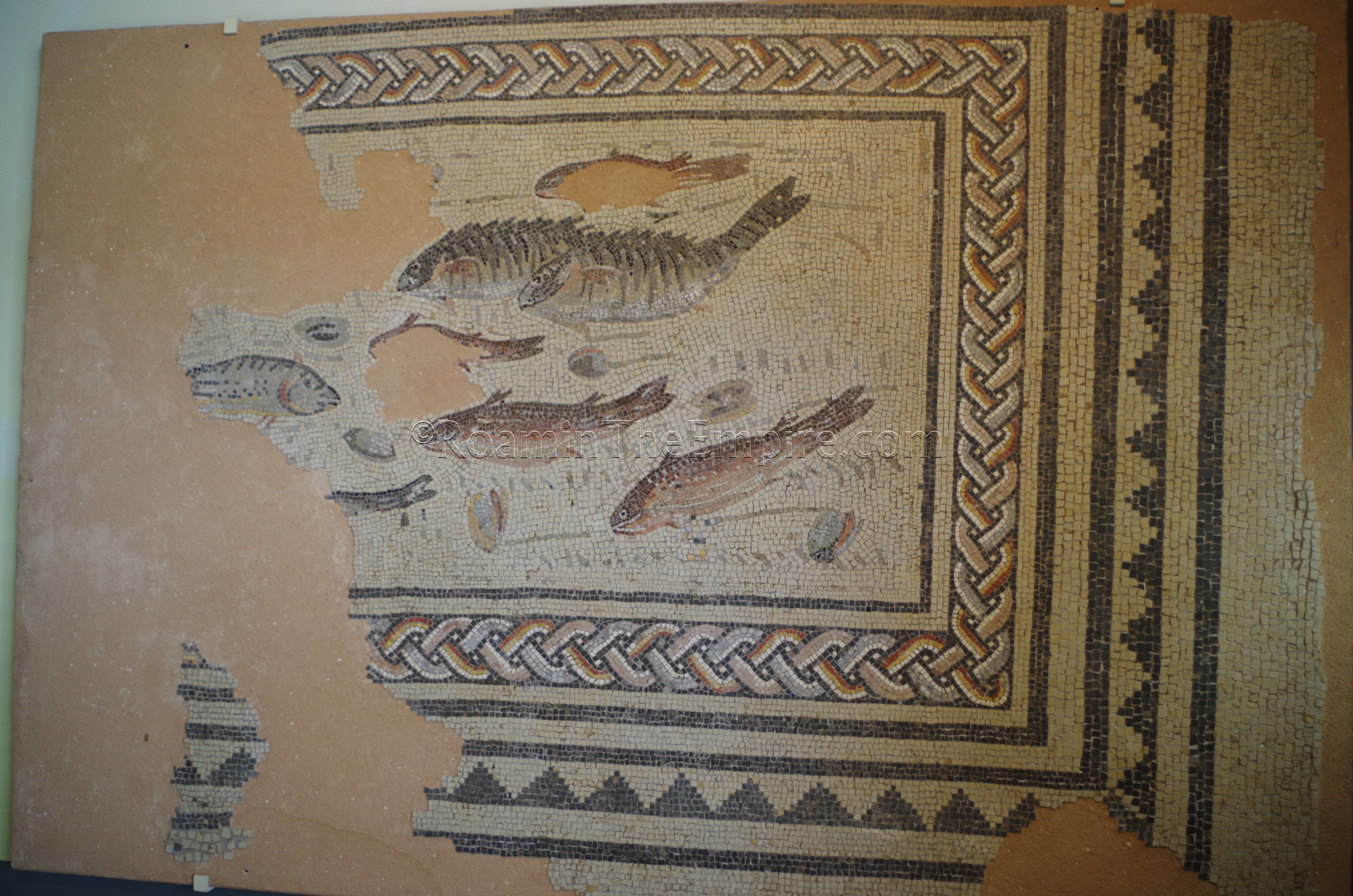
Museum
The on-site MuséAl is rather small, but has a few nice pieces. Most of the pieces in the permanent collection seem to be from the archaeological site (there was also a temporary exhibit when I visited which included some other objects from outside of the area). There are a few nice mosaics, including one with some images of fish from the triclinium of one of the villas in the vicinity of Alba Augusta Helviorum. There are a few fragmentary pieces of statuary and some larger epigraphic pieces, but the bulk of the collection are smaller finds. It took me about 20 minutes to go through the museum, and that was on a special archaeology day in which the museum was pretty jam-packed. On a regular day, it honestly probably would have taken me less. Most of the objects had informational signs, but only in French.
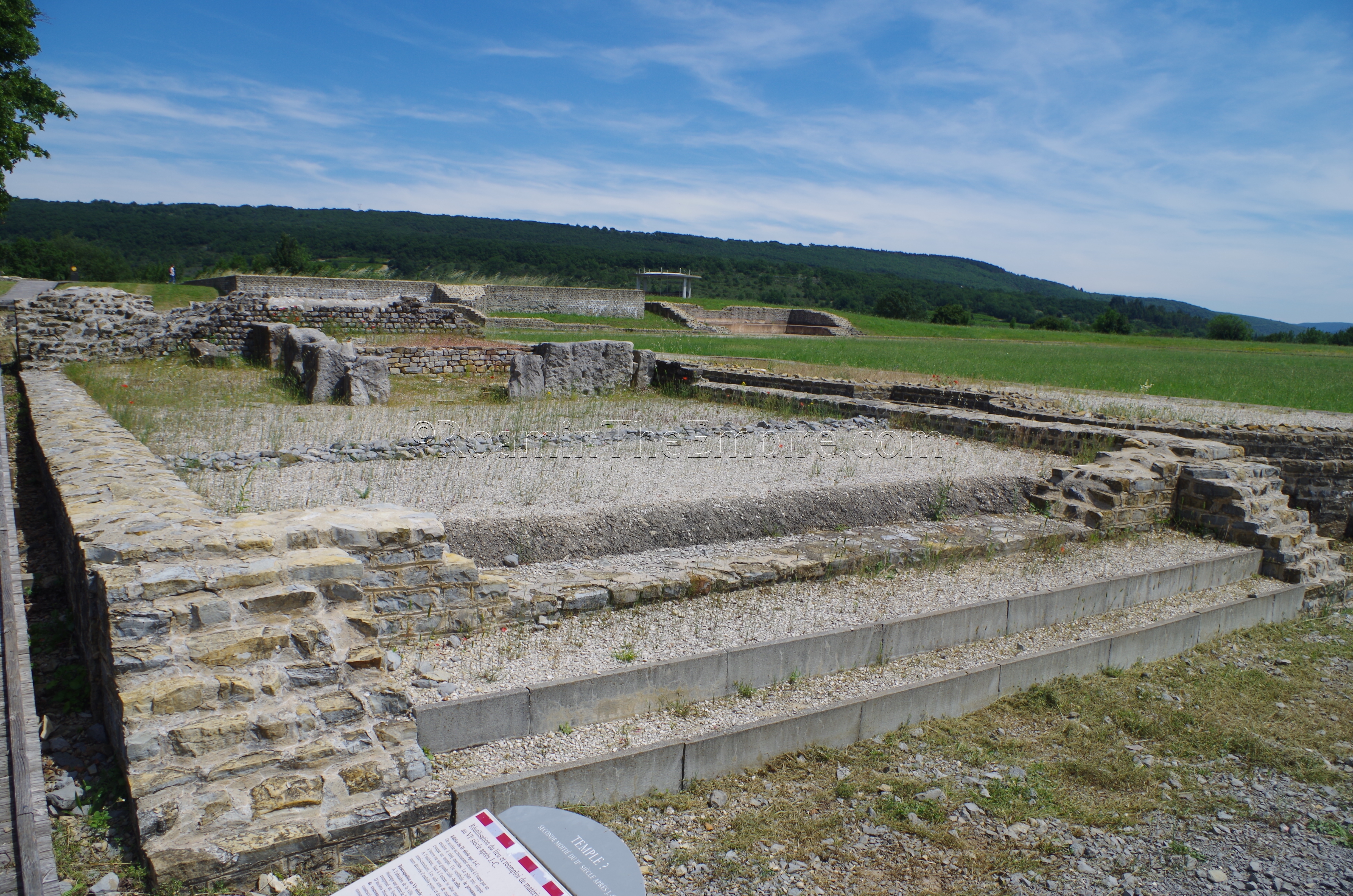
Forum Area
Most of what has been excavated of Alba Augusta Helviorum is within the archaeological park. There are a few villas to the south and some buildings to the west that have been excavated, but none of them are visible or able to be visited. The remains within the park consist of the theater, part of the forum area, and sanctuary area. The first of these encountered, upon leaving the museum, is the forum and monumental core area. The central feature of this is a large quadriporticus. Dating to the 2nd century CE, the quadriporticus features a pool and basin in the central open area, as well as exedrae and a few large rooms off the portico on the north and east. The western side of the quadriporticus is bordered by the cardo maximus, and along this road are a number of stalls that are identified as being shops. On the north side of the quadriporticus is structure that has been identified as being a temple, though no association with a deity or deities has been made. This building’s construction also dates to the 2nd century CE.
Immediately south of the quadriporticus is a building identified as the curia, surrounded by a cryptoporticus. None of the structure of the cryptoporticus, which dates to the end of the 1st century CE, remains, or at least none is excavated and on display. South of the curia and cryptoporticus is another temple structure, this one surrounded by a large area that would have been covered in geometric mosaic. Like the temple on the north end of the quadriporticus, there is no association with any deity made for it. The shops bordering on the east side of the cardo maximus continue along the western extents of these two areas as well. Further on south, though largely unexcavated, was the open area of the forum. The best preserved stretch of the cardo maximus lies southward along this forum area, adjacent to the D107 highway.
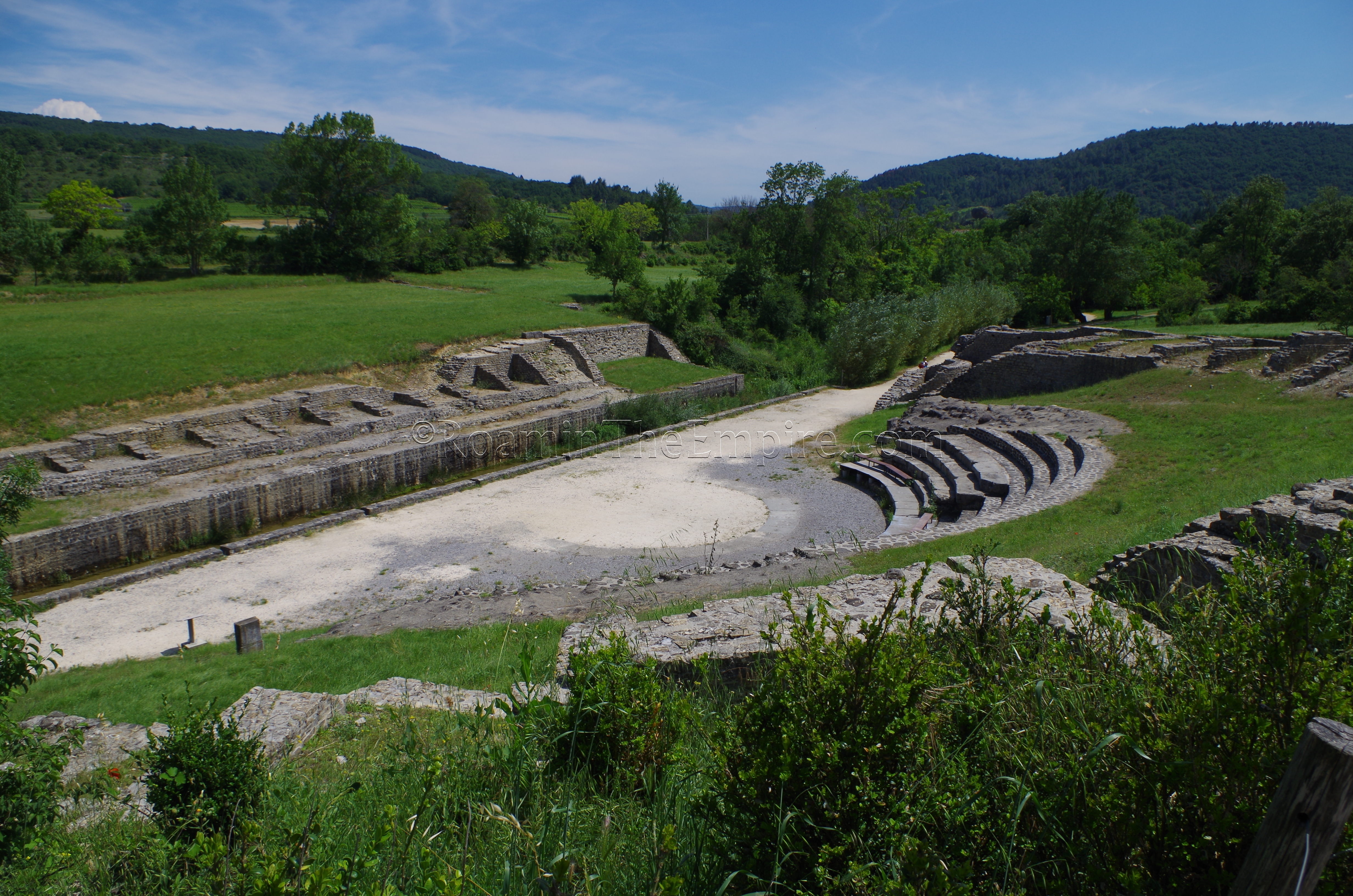
Theater
East of the forum area is the theater of Alba Augusta Helviorum. A largely wooden and earthen theater seems to have been constructed on the site during the reign of Augustus at the end of the 1st century BCE. About 30-45 CE, the theater was expanded and constructed in stone. The final form of the theater, visible today, was constructed in the 2nd century CE and ultimately had a capacity of 5,000-6,000 spectators. Interestingly, a stream currently cuts between the cavea and the rear of the theater, with the pulpitum of the theater seemingly spanning the stream, and it seems as though that separation existed in antiquity as well, making it quite a unique layout.
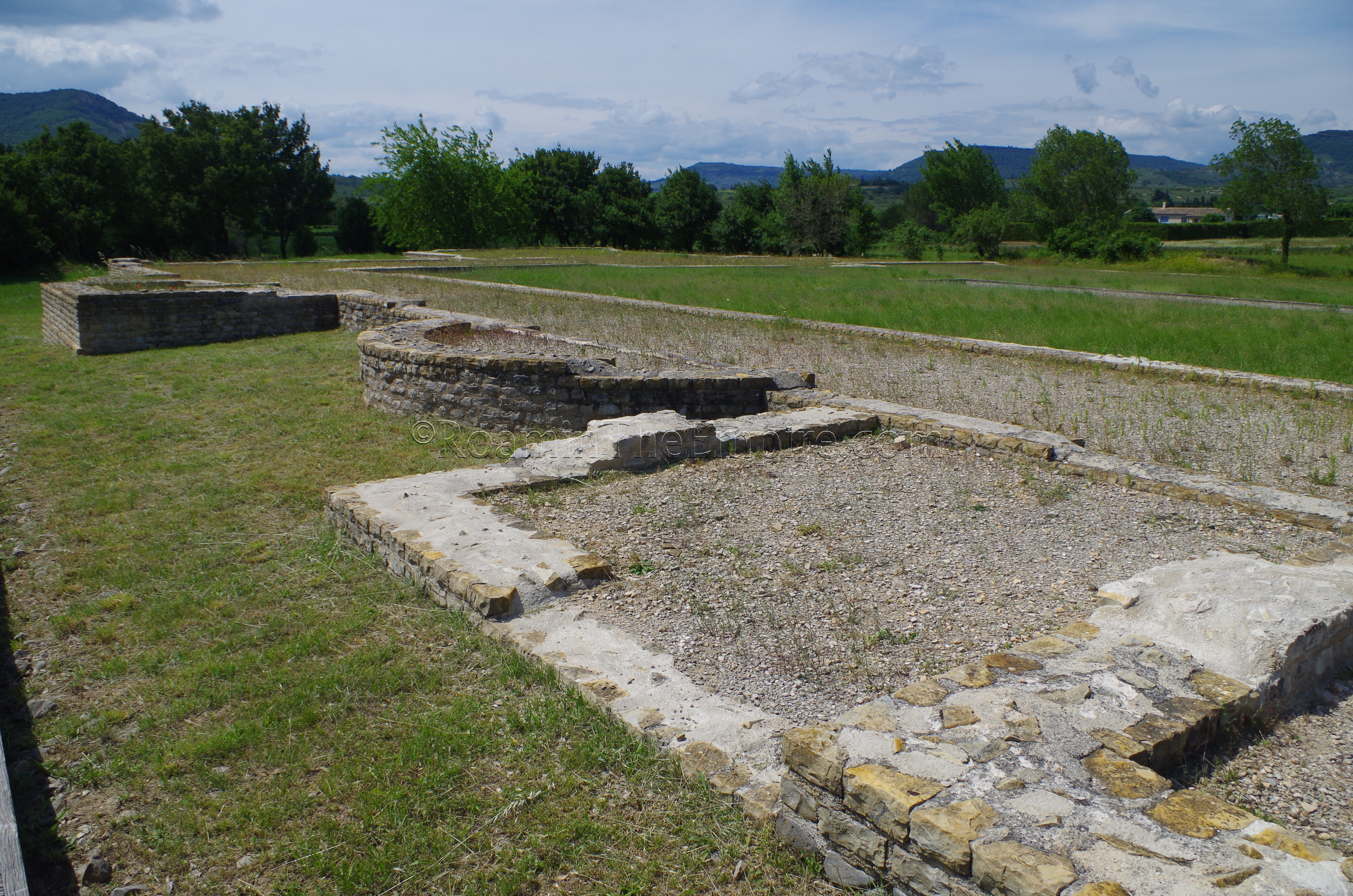
Tracking back a little bit, just to the north of the quadriporticus is another similarly structured but smaller building of unclear use. Like the quadriporticus, it is essentially a large open area surrounded on four sides by a portico. Within the open area in the center is a pool, and there are a few exedrae off the portico. The building is theorized to be of economic and/or religious use. Some inscriptions found in this building have indicated that it may have been used by collegia that were possibly associated with the viticulture industry in the town. This structure dates to the 2nd century CE. The orientation of this building may indicate that it is associated with the sanctuary site further north.
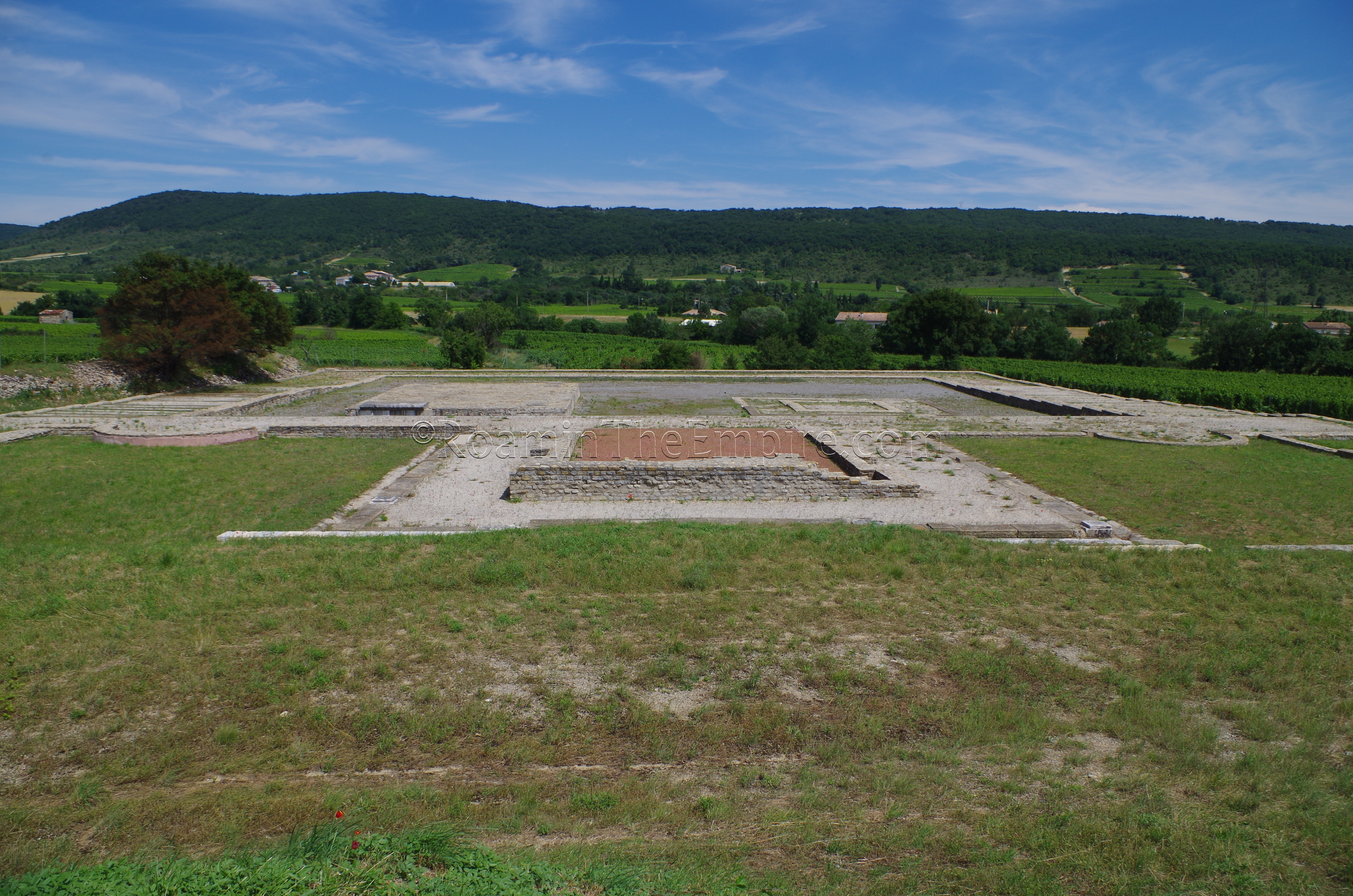
Bagnols Complex
The final set of remains at the archaeological site are a bit away from the rest of the site. It’s not a far walk, only about 5 minutes north of the possible collegia building, but there is really only one sign directing visitors toward it, and the path seemingly takes one outside of the site. I noticed a few confused people it the initial stretch, unsure if they were walking in the right direction, or whether there was anything out there. There is indeed a worthwhile building to visit out there, so it is worth the short walk and potential confusion. This part of the site is known as the Bagnols complex, perhaps due to it originally being thought to be a bathing complex. In reality, it seems to be a religious complex dedicated to the imperial cult.
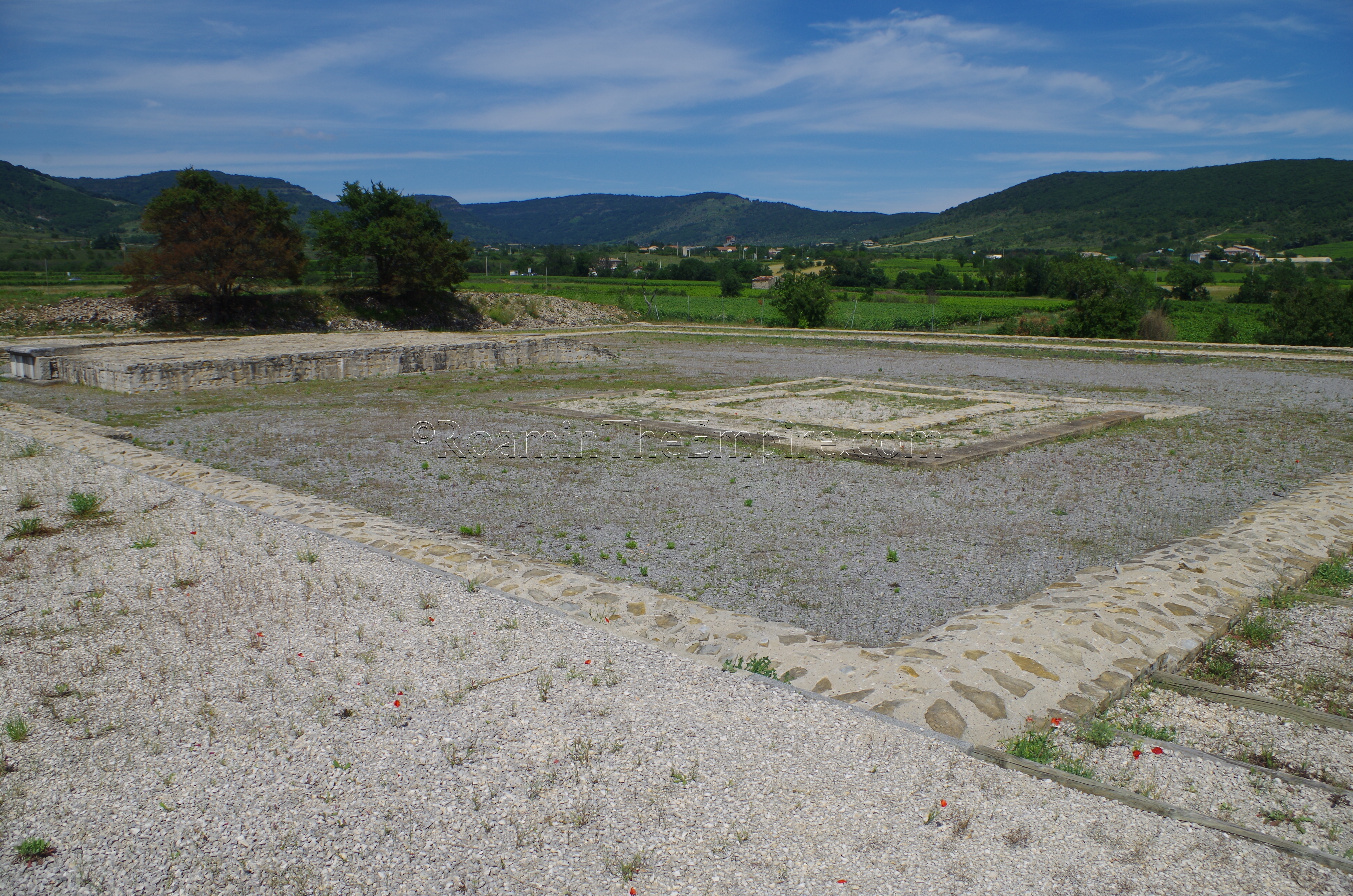
The complex seems to be built on the site of a Gallic sanctuary, indicated by the presence of a Gallo-Roman fanum temple. Originally constructed about 10 CE, the sanctuary features a familiar structure among buildings at Alba Augusta Helivorum; a quadriporticus. Within the quadriporticus are the fanum temple (south) and a more classical style Roman temple (north). An axial temple is also part of the original plan on the west side of the portico. In the 2nd century CE, the sanctuary undergoes major renovations that include the construction of the courts adjacent to the axial temple, the staircase added to the portico, and the construction of a basin within the portico. A statue of an emperor dating to the 2nd century CE found here (on display in the museum) seems to be the primary evidence to suggest the use of the sanctuary in association with the imperial cult.
Overall, the Site Archéologique d’Alba la Romaine is presented nicely. There seems to be a high degree of reconstruction, but, there are quite a few interesting buildings that make a stop worthwhile for that alone; the theater, in particular, being among them. There are informational signs for most of the buildings here, though nearly all the information is presented solely in French. In addition to the 20 minutes or so at the museum, I spent about an hour on the site, clocking the entire stop in at around an hour and a half.
Sources:
Bromwich, James. The Roman Remains of Southern France: A Guidebook. London: Routledge, 1996.
Julius Caesar, Commentarii de Bello Gallico, 1.35, 1.47, 7.7-8, 7.64-65, 7.75.
Pliny the Elder, Naturalis Historia, 3.5, 14.43.
Smith, William. Dictionary of Greek and Roman Geography. Walton & Murray, 1870.
Stillwell, Richard, William L. MacDonald, and Marian Holland. McAllister. The Princeton Encyclopedia of Classical Sites. Princeton, NJ: Princeton U Press, 1976.


